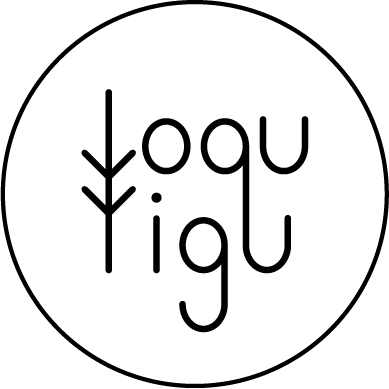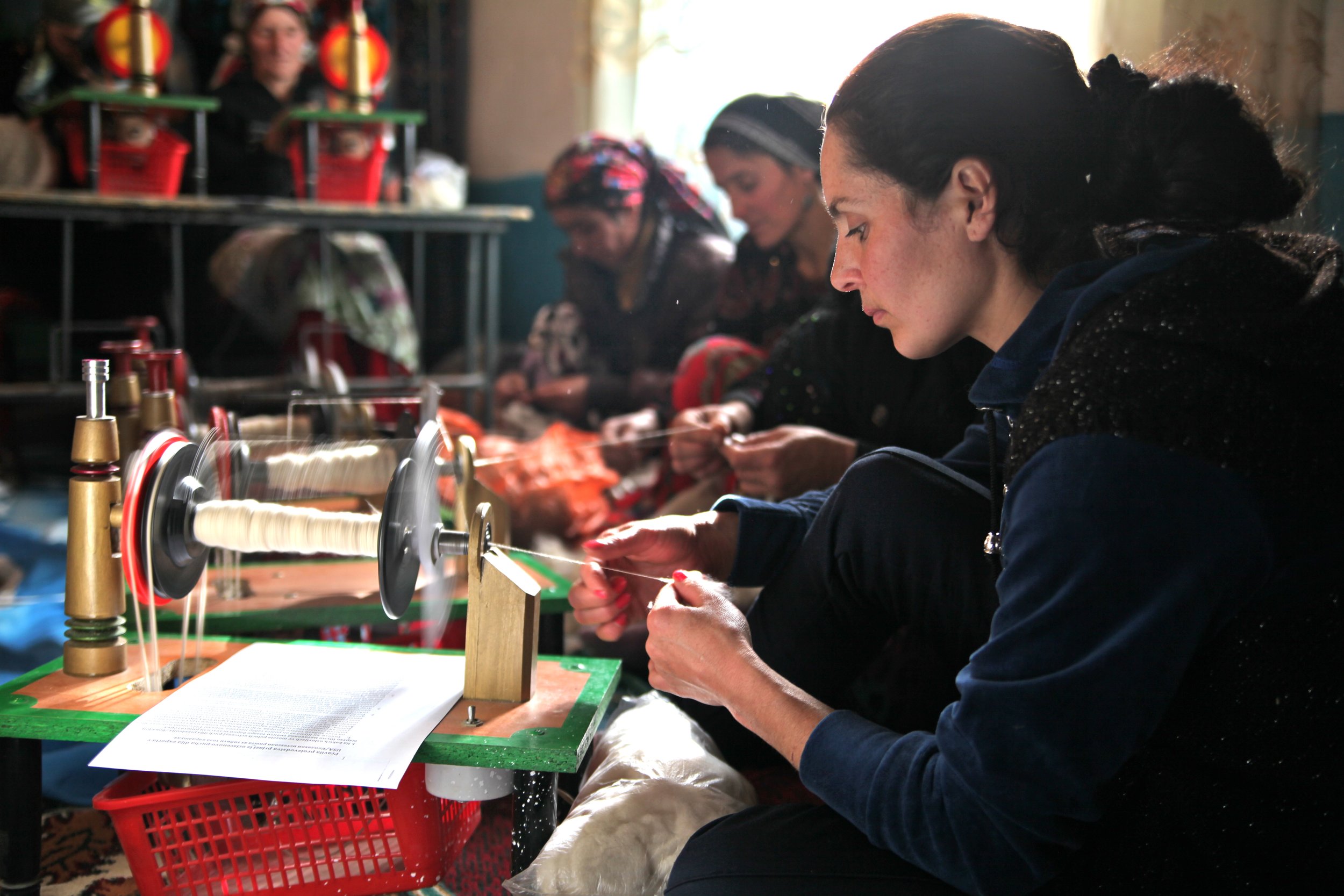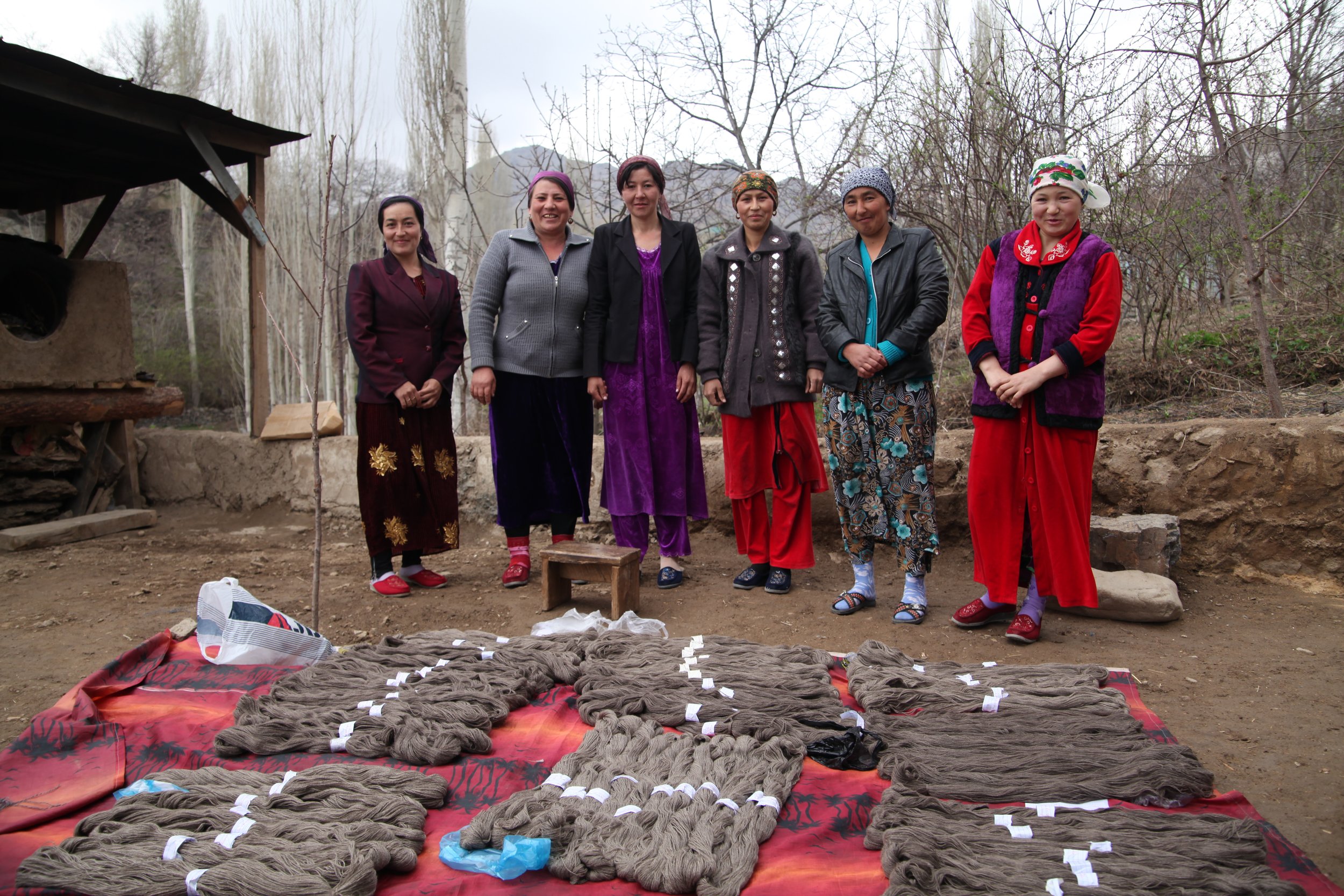Hi Casey! I’m glad for the opportunity to chat with you about Cashmere People Yarns - thank you for taking the time from your busy schedule! I’m very fascinated by Cashmere People Yarns, so please excuse my extreme nosiness LOL! So, how did Cashmere People Yarns begin?
Cashmere People Yarns began back in 2009 with a four-year grant from the International Fund for Agricultural Development (IFAD), based in Rome, Italy. The goal was to improve the production and processing of high-value animal fibers and train local women to spin export quality yarns for the international market. The grant money was used to train farmers and provide the tools to comb their goats instead of shear them, resulting in fewer guard hairs. These fibers were purchased at a rate more than four times greater than the farmers would have received from the Chinese market. The funds were also used to establish eight spinning groups - three in northern Tajikistan, four in southern Tajikistan, and one in Afghanistan. Each group was outfitted with a workshops space, electric spinning wheels, and training. That first four-year grant was a success, and the project was awarded another four-year grant.
Training in spinning. Photo by Liba Brent (shared with permission by Casey Ryder)
Training in spinning in Markhamat village. Photo by Liba Brent (shared with permission by Casey Ryder)
How many people currently work for Cashmere People Yarns?
There are around 70-80 women employed within Cashmere People Yarns. Although each workshop space has a group leader, they make decisions as a group, including pay rates and pricing. Each woman has a key to the workshop space, so they are able to choose how much they work. Some have other jobs. They all have household responsibilities as mothers and (for many) heads of the household while their husbands live and work in Russia. About 40% of Tajikistan’s GDP is from remittances - husbands sending money home to their families, mainly from Russia. Many of the women in the north work on apricot farms in the summer. And the women in both the north and south have their own farms to tend to spring through fall.
I am their only distributor. And I wholesale to a little over 20 shops around the US and one shop in New Zealand.
Photo by Liba Brent (shared with permission by Casey Ryder)
It feels like you have a good relationship with the people at Cashmere People Yarns. I noticed recently you were running a fundraiser to help pay one of the spinners’ medical bills. Do you do these kinds of campaigns often?
I don’t run these campaigns too often. This is the second such fundraiser I’ve done. The first was to support them in their fiber purchase the second year I was working with them. We all want the business to be able to support the needs of the spinners and their families sustainably, but it has been slow to “take off.” It’s definitely been a learning curve for all of us… finding the right amount of yarn to make at the beginning and scaling up from there… that first number was hard to determine, and I think they just did what made financial sense with the grant money. But then adding in my role as the wholesale distributor, a role I had no previous experience in… well, it’s taken some time, but I think we’re on the right track!
I was able to travel there in 2017 for two weeks and got to meet most of the spinners. We drank a lot of tea, ate a lot of food, and danced together. Even though I had limited conversations (I don’t speak Russian or Tajik, or Uzbek), that time with them was really special. I felt so welcomed, and they were all so eager to share their time and hopes for their work. I hope to visit them again. But it really solidified in my mind and heart the importance of what they are doing for themselves and their families. It’s huge.
I love reading about Cashmere People Yarns spinners and learning more about them, their values, and what working for the cooperative means to them. It sounds like spinning for Cashmere People Yarns provides a significant income for the spinners’ households. I’m curious, how much do the hand-spinners make moneywise, say dollars per skein? What does this mean in terms of an hourly wage, and how does it compare to the living costs in the region?
Tajikistan is a very poor country. Its GDP ranks 149th out of 195 countries. Afghanistan’s GDP ranks 177th. The annual average household income per capita in Tajikistan is estimated to be around $810 for 2021.
The spinners are paid per meter based on the quality of their spinning. They have developed a rubric of sorts for examining each skein and determining the pay scale based on the quality and consistency of the yarn.
On average, spinners are paid between $25-$120 per month when they are spinning. It varies from spinner to spinner, depending on how often they are able to come into the workshop, but the average is $70 per month. Some spinners choose to work from home, too, especially during COVID. But working in the workshop space is meaningful to them outside of earning income for their families.
Profit sharing day. Photo by Liba Brent (shared with permission by Casey Ryder)
I know producing yarn costs a lot, and Cashmere People Yarns are unique because all the yarns are handspun. So, how does this translate into the price and also your employees’ income? For example, let’s take the price of one skein of Cashgora ($48). What percentage of it goes to pay the hand-spinner? And where does the rest go?
I pay Cashmere People Yarns $17 per skein, which is 35% of the retail price. They then use this money to pay the spinners and re-invest in their business - purchasing fiber, paying for processing, buying dyes, etc. I wholesale cashgora for $26.40 per skein, which is 45% off the retail price. The profits I make go back into my business. I don’t calculate the cost of the time I spend promoting their business, reaching out to potential wholesalers, working with designers, storing the yarn, or going to shows on their behalf. That’s all just all rolled into my work with PortFiber.
Each skein is spun so meticulously, and as a hand spinner myself, I’m amazed at the evenness and consistency! Do the spinners receive training or do only skilled spinners get employed?
I wasn’t involved with the training. Shahlo was (is) the head trainer over those eight years of being supported by grant money. (She is currently in Russia receiving treatment for breast cancer.) Each group has a leader who is responsible for maintaining a certain quality of yarn. Shahlo trained the group leaders. There are spinners in the groups who have not been able to spin an export-quality cashgora but use the workshop spaces to spin local wools to be sold in the local markets. Once a spinner can spin well with the wool, they can try their hand at the cashgora.
Some of the spinners did have experience spinning on drop spindles or hand-made crank wheels, kind of like a great wheel, but smaller. But the electric wheels are so much more efficient and not as hard on the body.
Drop-spindling. Photo by Liba Brent (shared with permission by Casey Ryder)
Spinning with a hand-crank spinning wheel. Photo by Liba Brent (shared with permission by Casey Ryder)
Could you please describe the process a bit more: from sheep to skein? Does the fiber get dyed before or after spinning?
The goats are raised in the Pamir Mountains in the southern part of Tajikistan. They are small flocks that belong to families, maybe 10-12 animals. The animals spend the warm months all together in mountain pastures. Families take turns tending to the larger flocks.
Pamir Mountains. Photo by Liba Brent (shared with permission by Casey Ryder)
Rokhzora with her goats. Photo by Liba Brent (shared with permission by Casey Ryder)
Around March, the goats are combed, and the fiber is collected and sold to the Cashmere People Yarns fiber buyer. (I can’t remember his name!) He goes around to the different villages, examines the fiber from the farmers, and pays them for it. All of the collected fiber is sorted into natural brown and natural white and then gets shipped to Herat, Afghanistan, to be dehaired. Even though the fiber is hand-combed, there are still guard hairs in there - you can’t avoid them all. These would make for a prickly yarn, so it is sent away to be dehaired at a facility that has been doing that for decades. The dehaired fiber is then sent back to Tajikistan and dispersed amongst the spinning groups there.
Combing cashgora. Photo by Liba Brent (shared with permission by Casey Ryder)
Buying cashgora. Photo by Liba Brent (shared with permission by Casey Ryder)
Cashgora before dehairing. Photo by Liba Brent (shared with permission by Casey Ryder)
Spinners in Andarob village (Pamir). Photo by Liba Brent (shared with permission by Casey Ryder)
The undyed fiber is spun and plied on electric wheels that were made by a man in Northern Tajikistan. Each bobbin can hold up to a kilo of yarn! They are some honkin’ big bobbins! The skeins are wound up on hand crank skein winders into 100g skeins. As each skein is handspun, the yardage varies from skein to skein.
There are three hand-dyers in the North - the three are group leaders there: Shahlo, Oygul, and Tulakhon. They dye the skeins in small batches on their stoves using acid dyes from the States (I’ve shipped them some) and from Turkey. The color palette is gorgeous. Some of the skeins start out a natural white and some a natural brown, so there is really a lovely depth to the colors. Each skein is tagged with a picture of the woman who spun it, the name of the color, and the yardage/meterage, and they are shipped to me in Portland.
Spinners in Andarob village. Photo by Liba Brent (shared with permission by Casey Ryder)
Spinners in Markhamat village. Photo by Liba Brent (shared with permission by Casey Ryder)
Spinners in Oshoba village. Photo by Liba Brent (shared with permission by Casey Ryder)
Workshop in the Pamirs. Photo by Liba Brent (shared with permission by Casey Ryder)
With the situation in Afghanistan, what is happening with the cooperative members in that region?
I’m getting mixed messages. There is a group leader for one of the spinning groups in southern Tajikistan that I am in touch with, and she says everyone is doing fine. But another person I work with says that they are afraid and wary of communicating that fear. I don’t have any direct contacts in Afghanistan.
Afghan spinners. Photo by Liba Brent (shared with permission by Casey Ryder)
I hope they are okay.
Have you traveled to that region? Does working with Cashmere People require a lot of traveling for you?
I haven’t traveled internationally, other than that initial visit to Tajikistan, which was paid for with grant money. I do travel for retail and wholesale trade shows and would love to do more of that in the future.
Does working with Cashmere People require a lot of work on your part?
It is a whole job in and of itself, one that I would like to dedicate more time to. I’m in the process of figuring out how to responsibly hire someone to help me in my shop so that I have more time to focus on growing Cashmere People Yarns.
What does the future hold for Cashmere People Yarns? What are your plans and hopes for it?
My hope is that I am able to scale up to a point where I don’t really have a lot of backstock. I want to sell all of what they ship me or at least most of it. There is only a limited quantity - part of the whole project is focused on sustainable agriculture. They are not going to breed more and more goats because it would not be good for the land. So there is a finite yearly quantity. Granted, there is still fiber being sent to the Chinese market, so there is perhaps a little room for growth. However, that infinite, Capitalistic growth model is not the goal here. With that in mind, and just knowing how obsessed we all are with great yarn, it seems feasible to sell out of a given year’s production.
Photo by Liba Brent (shared with permission by Casey Ryder)
I’d love to be able to reinvest profits into Cashmere People Yarns. Or help to fund other projects within the spinning groups and farming communities.
I want this yarn in the hands of makers who get it, who understand how special it is, and who get hooked on working with some of the best stuff out there! I honestly think it is underpriced, given it is handspun cashgora, and it directly impacts women in developing countries! I sometimes want to reach through my computer, hold onto a shop owner's shoulders and say, “Just get it for your shop!” I mean, especially if they are already selling cashmere or other pricey yarns that AREN’T handspun by women in developing countries!
Photo by Liba Brent (shared with permission by Casey Ryder)
I have a Dream Team Google Doc where I have a list of shops that I’d love to see stock Cashmere People Yarns, plus a list of designers, other yarn producers, and publications I’d love to partner with. This is where I go when I sit down to do what, in my mind, I refer to as “cold calls,” which really is just emails because who wants to talk on the phone these days?! I seek out shops that carry local yarns and indie-dyed yarns because I automatically know they value a smaller, (probably) more sustainable production scale. It’s been difficult not being able to go to shows and have people just touch the yarn. All you have to do is touch it to know it’s some good, good stuff!
In Tajikistan, they are working on building a fiber processing facility of their own. I think it’s still a ways away from being complete, but that will hopefully add more income opportunities for folks and cut down on some of the production costs.
They are also starting to spin and dye cotton, which is grown in northern Tajikistan!
I would love to be able to visit them again. And dance with them and drink tea together and share more of their story with the fiber community at large!
Spinning group leader, Barvoz village, Pamir. Photo by Liba Brent (shared with permission by Casey Ryder)
Woman with goats, Pamir. Photo by Liba Brent (shared with permission by Casey Ryder)
Thank you again, Casey, for this interview and for sharing the story of Cashmere People Yarns!
If anybody reading this blog post would love to check out Cashmere People Yarns, please visit www.CashmerePeopleYarns.com and @CashmerePeopleYarns on Instagram. Also, take a look at this collection of patterns featuring Cashmere People Yarns on Ravelry.
In collaboration with Casey, I designed a sweater pattern with Cashgora Sport yarn. The sweater design is called Rhythm and Rhyme, and it’s available both on my website and my Ravelry store.























